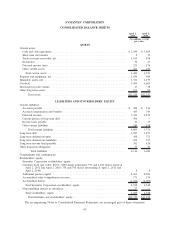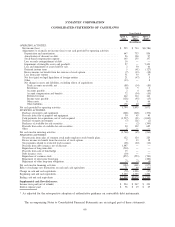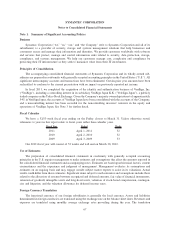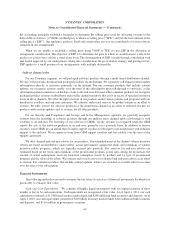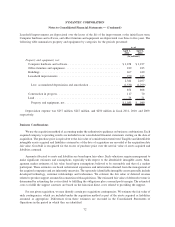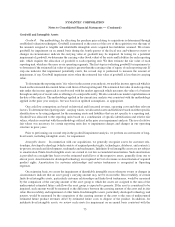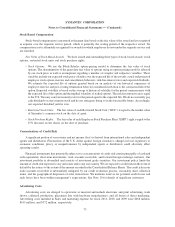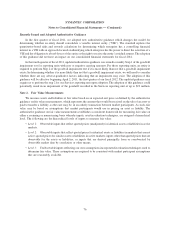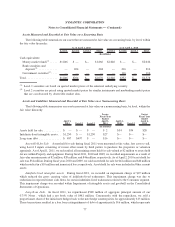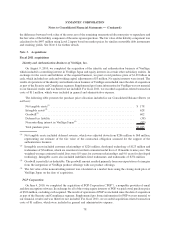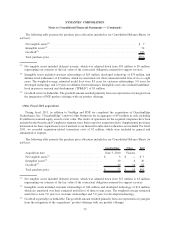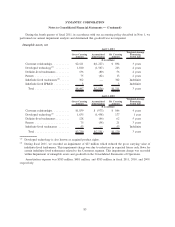Symantec 2011 Annual Report Download - page 143
Download and view the complete annual report
Please find page 143 of the 2011 Symantec annual report below. You can navigate through the pages in the report by either clicking on the pages listed below, or by using the keyword search tool below to find specific information within the annual report.Goodwill and Intangible Assets
Goodwill. Our methodology for allocating the purchase price relating to acquisitions is determined through
established valuation techniques. Goodwill is measured as the excess of the cost of the acquisition over the sum of
the amounts assigned to tangible and identifiable intangible assets acquired less liabilities assumed. We review
goodwill for impairment on an annual basis during the fourth quarter of the fiscal year and whenever events or
changes in circumstances indicate the carrying value of goodwill may be impaired. In testing for a potential
impairment of goodwill, we determine the carrying value (book value) of the assets and liabilities for each reporting
unit, which requires the allocation of goodwill to each reporting unit. We then estimate the fair value of each
reporting unit, which are the same as our operating segments. The first step in evaluating goodwill for impairment is
to determine if the estimated fair value of equity is greater than the carrying value of equity of each reporting unit. If
step one indicates that impairment potentially exists, the second step is performed to measure the amount of
impairment, if any. Goodwill impairment exists when the estimated fair value of goodwill is less than its carrying
value.
To determine the reporting units’ fair values in the current year analysis, we used the income approach which is
based on the estimated discounted future cash flows of that reporting unit. The estimated fair value of each reporting
unit under the income approach is corroborated with the market approach which measures the value of a business
through an analysis of recent sales or offerings of a comparable entity. We also consider our market capitalization on
the date of the analysis. The methodology applied in the current year analysis was consistent with the methodology
applied in the prior year analysis, but was based on updated assumptions, as appropriate.
Our cash flow assumptions are based on historical and forecasted revenue, operating costs and other relevant
factors. To determine the reporting units’ carrying values, we allocated assets and liabilities based on either specific
identification or by using judgment for the remaining assets and liabilities that are not specific to a reporting unit.
Goodwill was allocated to the reporting units based on a combination of specific identification and relative fair
values, which is consistent with the methodology utilized in the prior year impairment analysis. The use of relative
fair values was necessary for certain reporting units due to impairment charges and changes in our operating
structure in prior years.
Prior to performing our second step in the goodwill impairment analysis, we perform an assessment of long-
lived assets, including intangible assets, for impairment.
Intangible Assets. In connection with our acquisitions, we generally recognize assets for customer rela-
tionships, developed technology (which consists of acquired product rights, technologies, databases, and contracts),
in-process research and development, trademarks and tradenames. Indefinite-lived intangible assets are not subject
to amortization. Finite-lived intangible assets are carried at cost less accumulated amortization. Such amortization
is provided on a straight-line basis over the estimated useful lives of the respective assets, generally from one to
eleven years. Amortization for developed technology is recognized in Cost of revenue as Amortization of acquired
product rights. Amortization for customer relationships and certain tradenames is recognized in Operating
expenses.
On an interim basis, we assess the impairment of identifiable intangible assets whenever events or changes in
circumstances indicate that an asset group’s carrying amount may not be recoverable. Recoverability of certain
finite-lived intangible assets, particularly customer relationships and finite-lived tradenames, would be measured
by the comparison of the carrying amount of the asset group to which the assets are assigned to the sum of the
undiscounted estimated future cash flows the asset group is expected to generate. If the asset is considered to be
impaired, such amount would be measured as the difference between the carrying amount of the asset and its fair
value. Recoverability and impairment of other finite-lived intangible assets, particularly developed technology and
patents, would be measured by the comparison of the carrying amount of the asset to the sum of undiscounted
estimated future product revenues offset by estimated future costs to dispose of the product. In addition, for
indefinite-lived intangible assets, we review such assets for impairment on an annual basis consistent with the
73
SYMANTEC CORPORATION
Notes to Consolidated Financial Statements — (Continued)


